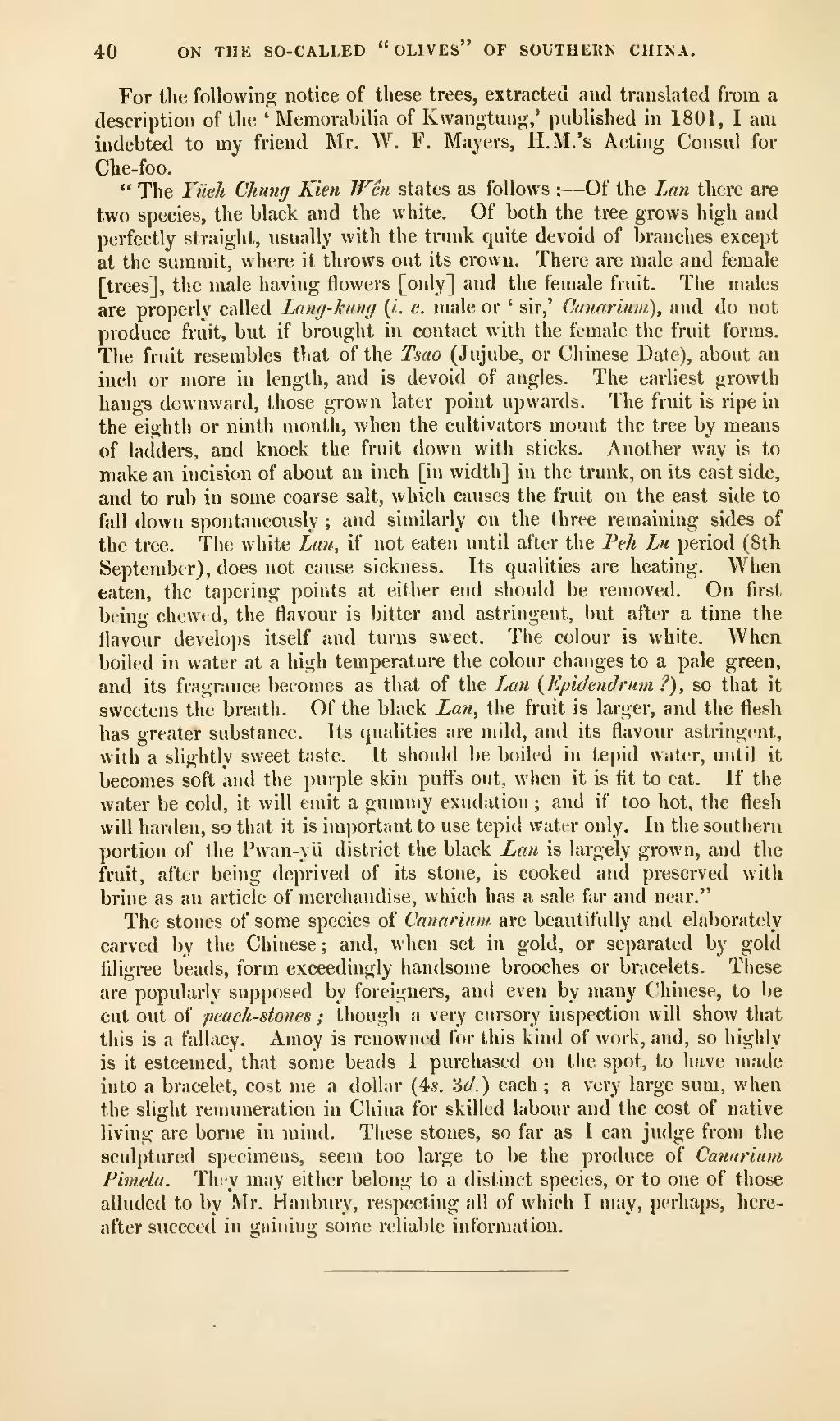40 ON THE SO-CALLED " OLIVES OF SOUTHERN CHINA,
For tlie following notice of these trees, extracted and translated from a description of the ' Memorabilia of Kwangtniig,' published in 1801, I am indebted to my friend Mr. W. F. Mayers, H.M.'s Acting Consul for Clie-foo.
" The Yi'ieh Chung Kieti Wm states as follows : — Of the Lan there are two species, the black and the white. Of both the tree grows high and perfectly straight, usually with the trunk quite devoid of branches except at the summit, where it throws out its crown. There are male and female [trees], the male having flowers [only] and the feuiale fruit. The males are properly called Lnug-knng (/'. e. male or ' sir,' Cauarium), and do not produce fruit, but if brought in contact with the female the fruit forms. The fruit resembles that of the Tsao (Jujube, or Chinese Date), about an inch or more in length, and is devoid of angles. The earliest growth hangs downward, those grown later point upwards. The fruit is ripe in the eighth or ninth month, when the cultivators mount the tree by means of ladders, and knock the fruit down with sticks. Another Avay is to make an incision of about an inch [in width] in the trunk, on its east side, and to rub in some coarse salt, which causes the fruit on the east side to fall down spontaneously ; and similarly on the three remaining sides of the tree. The white Lan, if not eaten until after the Pe/i Lu period (8th September), does not cause sickness. Its qualities are heating. When eaten, the tapering points at either end should be removed. On first being chewt d, the flavour is hitter and astringent, but after a time the flavour develops itself and turns sweet. The colour is white. When boiled in water at a high temperature the colour changes to a pale green, and its fragrance becomes as that of the Lan {Epidetidruvi ?), so that it sweetens the breath. Of the black Lan, the fruit is larger, and the flesh has greater substance. Its qualities are mild, aiul its flavour astringent, wiih a slightly sweet taste. It should be boiled in tepid water, until it becomes soft and the purple skin puft's out, when it is fit to eat. If the water be cold, it will emit a gummy exudation ; and if too hot, the flesh will harden, so that it is important to use tepid water only. In the southern portion of the Pwau-yli district the black Lan is largely grown, and the fruit, after being deprived of its stone, is cooked and preserved with brine as an article of merchandise, which has a sale far and near."
The stones of some species of Canariiun are beautifully and elaborately carved by the Chinese ; and, when set in gold, or separated by gold filigree beads, form exceedingly handsome brooches or bracelets. These are popularly supposed by foreigners, and even by many Chinese, to be cut out of peach-stones ; though a very cursory inspection will show that this is a fallacy. Amoy is renowned for this kind of work, and, so highly is it esteemed, that some beads I purchased on the spot, to have made into a bracelet, cost me a dollar (4s. '6cl.) each ; a very large sum, when the slight remuneration in China for skilled labour and the cost of native living are borne in mind. These stones, so far as I can judge from the sculptured specimens, seem too large to be the produce of Canariiim Pimela. They may either belong to a distinct species, or to one of those alluded to by Mr. Hanbiuy, respecting all of which I may, perhaps, here- after succeed in gaininsj; some reliable information.
�� �
